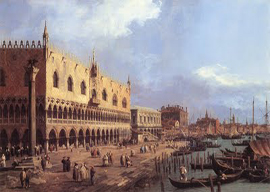
October 10, 2010

Palazzo Ducale Riva Degli Schiavoni by Canaletto
An international shouting match is underway over the fate of the city everyone loves but no one wants to live in: Venice. It started back in 2008, after Venice ran out of cash to maintain its more famous monuments. To cover some of the repairs on the Palazzo Ducale and the Bridge of Sighs (through which Giacomo Casanova made a famous escape), the local administration allowed the restorers to raise money by selling advertising space on their building scaffolds. This caused mild irritation when the sponsors were Moët Chandon and Bulgari. I, for one, did not mind seeing Julianne Moore’s pretty face touting Bulgari jewels from my gondola in the Grand Canal.
Last summer, however, Coca-Cola bought some space, and the aesthetic world went mad. Coca-Cola’s spokesman may have stretched the truth when he defended its Venetian ads by saying, “When we advertise, we are always conscious of local and artistic heritage.”
Of all people to complain about defacing public space, who should sign the letter composed by Britain’s Venice in Peril Fund but a bunch of architects who have done more substantial damage to our cities” prospects than any temporary product-hawking on a scaffold? Venice in Peril’s chairwoman, Anna Somers Cocks, informed the press: “Frank Gehry, Rem Koolhaas, and Norman Foster visited and were aghast [at the ads].” Foster, who gave London the giant television known as City Hall, and his colleagues were so aghast that they signed the letter accusing the Venice mayor’s office of “ruining Venice’s beauty.” (Was not the Thames beautiful once, oh Norman?)
Italian culture, whether it involves preserving opera or the Colosseum, is suffering due to the bankers” mismanagement and Silvio Berlusconi’s venality. The Ministry of Culture budget for restoring architectural masterpieces has been reduced to about $46 million this year. Of that, less than $2 million goes to all of the Veneto, of which Venice forms only a part. For Venice’s share, you”d be lucky to repair a vaporetto. One wag suggested that money seized from the Mafia should go to a Venice fund. Why not? It would save a few dozen Venetian palaces.
Outdoor ads that run from Santa Maria della Salute to the Lido are not Venice’s problem. The fact that the local government had to hold its beggar’s cap out to international advertisers is a symptom, not a cause, of Venice’s plight. Venice is suffering from depleted revenue (because most Italians avoid taxes) and population loss. There were about 180,000 people in Venice when Columbus found America. By 1950, the number had barely changed at 174,000, but by 1996 there were only 70,000. A few years later, when I lived in Nick Scott’s beautiful palazzo beside the Grand Canal, there were only 65,000. Now, they say, there are fewer than sixty thousand and still falling.
If Venice is to live, it doesn”t have to remove Coca-Cola signs. It needs people. Most of the Venetians who sought real jobs that didn”t involve selling postcards to tourists have moved across the water to Mestre. In that industrial center with a large harbor, they worked in factories, offices, shops, and other businesses that served a settled population. Venice has nothing to offer its children. Most Venetians leave when they finish school and return when they retire. You see small children and a lot of old folks when you spend time there. They are great people, but they are too few to bring the place alive. On summer days, there are more day-trippers than residents. The reason its restaurants are so lousy is that most customers eat there once and never return. Why fret about giving such people overpriced bad food?
Rather than complain about a few placards blocking a palace’s view, those who claim to care about Venice should do something to bring down the rents. Most rich Venetians live by renting out sections of family palazzi they have owned for generations. They don”t lower the rent to reflect lack of demand, because sooner or later some rich sucker will come along and pay top dollar for a view of the Lido.